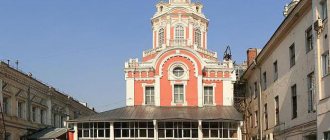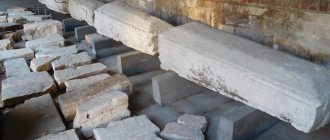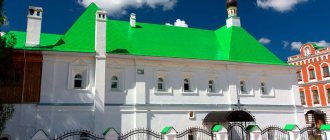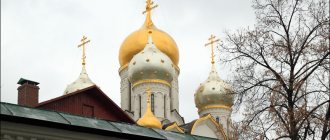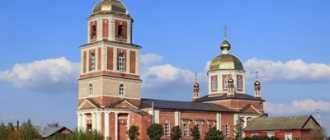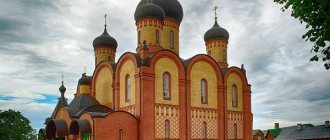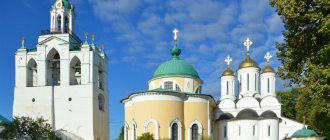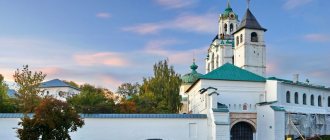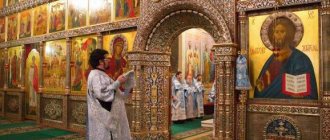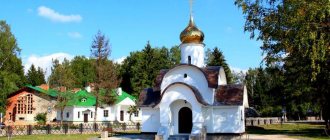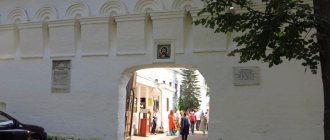Surely many would be as curious to know about this architectural complex as I was at one time. Once upon a time, this particular monastery was considered one of the most comfortable in Russia.
He was an example for other monasteries to follow and raised many famous wise people. According to legend, the Apostle Andrew the First-Called himself brought the Orthodox faith to these shores. There is no definite answer to when the community arose here, but Abraham of Rostov can find the first description dating back to the 10th century.
This shrine is the phenomenon of a real miracle in the history of the Russian church; not a single building has managed to be restored every time after so much destruction to zero. Once upon a time, a very long time ago (there is no exact date), along with belief, asceticism with traditions from Egypt and Byzantium came here - historians think that the monks Sergius and Herman rooted monasticism here. Their lives, unfortunately, have not been preserved.
According to some sources, they came from Greece. It is all the more interesting that on the Internet in many sources you can see another name given to Valaam - “Northern Athos”. And indeed, the local charter has always been distinguished by its spiritual severity, comparable only to the ascetic lifestyle of the Athonite elders. Read about another “New Athos” here.
This is how, starting from the most ancient mentions, which are more like legends than historical documented facts, this land reveals to us its true essence - a holy land marked by God, John of Kronstadt once said:
“On every stone on Valaam you can serve the liturgy.”
History of the formation of the monastery
The history of the monastery is fascinating and full of mysterious and exciting events associated with the revival of lost treasures of antiquity.
Before the Spaso-Preobrazhensky Monastery acquired its current appearance, it went through a long path of repeated complete destruction and desecration, and in the end it was still resurrected by skillful hands.
What was the monastery like that we never saw
Every time I am horrified when I understand whose life was attempted by those who came to destroy the monastery - in fact, they killed old men and young men who never wished harm to anyone, who with their own hands erected something that was overnight destroyed many times. The photo shows the monks and their students - 1887.
From the archives we know that the first monastery was built in honor of the Holy Trinity, and all the buildings were made entirely of wood. Unfortunately, everything was soon destroyed to the ground. This happened long before, in 1581, the lives of the new inhabitants of the monastery were ruined by the plague epidemic.
Then in the 16th century there was an attack by the Swedes, and in 1611 the refuge of holy people on Valaam was again destroyed, after which the monastery did not exist for more than 100 years. When I read such dry and so distant historical facts, I imagine how much is behind them - these are entire eras.
And now, after 100 years, the monastery was restored by new ascetics.
But more than one terrible destruction awaited the monastery. On April 3, 1754, there was a severe fire - only a few shrines were saved. Despite the tragedy, the monks rebuilt everything in two years.
Just imagine what dates the history of the monastery walls appeals to. A century passed - the monastery was destroyed, another century - it was restored. And what were the conditions for life and construction then - northern waters, a wild, uninhabited island. But monasticism on Valaam survived.
In the photo there are monks on Valaam - 1887.
With the help of the great Russian rulers (John Vasilyevich IV, Mikhail Feodorovich, Empress Elizabeth Petrovna, Feodor Ioanovich, Peter I, Nicholas II, etc.), who at different times allocated funds and decrees for the restoration of the monastery, all the churches on the island again and again were reborn.
On March 7, 1782, Hieromonk Nazarius from the Sarov Hermitage became the abbot of the monastery. He developed the first plan of the stone building of the monastery and the buildings around it.
And in the 19th century they decided to reconstruct the cathedral.
Construction began under Abbot Damaskin. The architect A. M. Gornostaev took up the matter (1852), the plan was completed, but in 1862 the architect died and construction began only under Abbot Jonathan II. A new project was ordered to the architect A. Ya. Silin.
The cathedral, which has survived to this day, was built jointly with the architect G.I. Karpov and architect N.D. Prokofiev. Construction was completed in 1892.
But the story does not end there - there is still a terrible 20th century ahead.
The events of 1914 also affected Valaam, despite its remoteness. The First World War began and life on the island fell into disrepair. And in 1923, the final fact for the newly restored monastery was the transition to the Gregorian calendar style. A split occurred on Valaam - as if a harbinger of a future split in the country. And on March 19, 1940, Valaam, which had not been at the disposal of the Finns for long, went to Russia. The monks were forced to retire to Finland and, having managed to save the main shrines, founded a new Valaam monastery in Finland.
The former Valaam, the shelter of virtue, faith, and culture of our country, was dismantled into bricks; wooden chapels and temples, rebuilt by the hands of monks, were used for firewood and a school for young boys, a state farm, and later a boarding school for war invalids began to be built on the island. But a full-fledged city did not work out here - life on the island has always been difficult.
The events of the late 80s marked the beginning of the restoration of the monastery in the form in which we can see it now. In 1990, the monastery received the status of stauropegial (that is, subordinate to the patriarch).
You can read more about the monastery on the website of the Valaam Monastery, and about the island in the article about Valaam.
What is the monastery like now?
Today the community is thriving. Every season, pilgrims, workers, volunteers and just tourists are welcomed here. The island has cafes, hotels, many operating hermitages, well-established production and much more.
I remember when I first arrived at the monastery, it was a beautiful, sunny day and then I was little interested in the cathedral and divine services, more in nature and the local way of life. Everything was so new and somehow unusually pleasant and warm. “In the city you lose the habit of two things: kindness and freedom,” I thought then; people simply don’t have time to do anything with their endless everyday life and activities.
I also noticed that at different times of the year the atmosphere here is perceived differently. In winter, for example, the space around seems to narrow, becomes stricter and seems to be wrapped in a veil of increased holiness, and in summer everything is so lively, joyful, bustling - so many colors and people around and for some reason it becomes lighter, freer - as if you had slept well.
Milestones in the development of the monastery
The rocky island on which the monastery is located rises high above sea level. There are several inland lakes connected by a network of canals. Pine trees grow on the islands. The place for the monastery was designated in the 1st century by Apostle Andrew the First-Called, who preached the Orthodox faith. Having overcome Rus' from south to north, the disciple of Christ found himself in the waters of Ladoga. Going to the mountains of Valaam, he erected a stone cross there. After 9 centuries, pilgrims from Greece reached the archipelago and formed a monastic brotherhood there.
The monastery was founded in 1407 , when monks from the Mediterranean Herman and Sergius appeared on the archipelago. Deciding to renounce worldly goods, the monks preached the Christian religion and founded the first monastery.
The war between Russia and Sweden had a painful impact on the life of the monastery: in 1611, the archipelago became the territory of Sweden, and the conquerors destroyed the monastery. After the end of the Northern War, on the instructions of Peter I in 1715, the restoration of the monastery and the construction of churches on its territory began, but the wooden buildings and fence burned down. In 1781, stone buildings appeared around the monastery. They actively built on Valaam under the abbot John of Damascus. In the new cathedrals, the rector introduced strict rules and revived the tradition of eldership.
After the revolution of 1917, the territory of Valaam came under Finnish rule, where Orthodox believers were oppressed. In 1923, the monastery was de-Russified: services were conducted in Finnish, and the Gregorian calendar was introduced. Many monks left the monastery at this time, the rest suffered poverty and hunger.
In 1940, after the return to the USSR, the monastery was closed and a naval school . On the island there was a pulp mill, a weather station and a fish factory, a home for the disabled and a museum-reserve.
In 1989, the monastery received the monastery buildings that previously belonged to it. 6 monks appeared on the island, trying to revive the customs of Valaam. In 1991, the monastery was given the status of ancient pygia. In 2007, the consecration of the temple and the first Liturgy was conducted by Patriarch Alexy II.
About monasticism and the rules of the monastery
It was these people who managed to create literally heaven on earth in these harsh northern lands. If it were not for the shrines persistently restored by the monks, Valaam would now be much less comfortable.
Even the nature of the island helped them. The fact is that on Valaam the nature of the stone is slightly different. Gabbro-diabase is a rock that accumulates solar energy and then releases it, making the island warmer than the mainland. Maybe this fact allowed the monks in the 19th century to grow previously unknown plants on Valaam.
The end result was beautiful gardens - almost everything took root. There were more than 60 varieties of apples. In 1824, monk Paisiy grew 21 varieties of apple trees here, among them the unique variety “Ranet Valaam”. They collected currants, gooseberries, raspberries, watermelons, melons, pumpkins and much more. The weight of vegetables reached 30 kg, and this is taking into account the climate and the number of sunny days. Here the average temperature in July is 17 degrees. In 1869 there were 400 apple trees in the orchards.
Monasticism today
Today the monastery owns a cheese farm, a factory, a fishery, gardens, a stone-cutting and blacksmithing plant, and a fleet. There is a candle production, an icon-painting workshop, a library and even a mini recording studio. And the painting school is worth special attention.
There is a dairy farm on the island that is easily accessible on foot and where you can buy natural dairy products. They also bake their own bread here. There are also stables in the monastery, where you can also look if you really want.
On the island:
- 18 chapels;
- 10 worship crosses;
- 13 hermitages – 11 of them are active;
Read more about life on the island in the article about the island of Valaam.
History of the Valaam Monastery
- It is believed that Andrew the First-Called installed a stone cross on the island of Valaam while preaching the gospel in the North. The monastery itself was founded nine hundred years later by the monks Herman and Sergius, who were later canonized. Presumably they were Greeks.
- As for the time of the founding of the monastery, historians have not come to a consensus - the monastery could have appeared either during the period of the baptism of Rus' or later.
- Until the 14th century , there was no exact information about the way of life of the local monks, but since the 16th century, Valaam became the center of book printing in this region. The Swedes' attack on the island led to the fact that it became practically deserted, only monks lived here. They restored the monastery according to Peter's decree, completing the construction of temples, cells, and utility buildings.
- Until the beginning of the 19th century, the monastery grew and was rebuilt; A bell tower was erected here and bells were cast. The number of monks gradually increased, and the monastery flourished. The October Revolution was not fatal for the monastery, since the territory on which the monastery was located went to Finland. The islands were thoroughly fortified for military purposes, but they did not close the monastery, but they forced them to switch to the Gregorian calendar. Since then, there has been a split between the brethren, and some of the monks moved to other countries.
- In the winter of 1940, the last monks left here, taking with them icons and other valuables. They founded New Valaam , which is still active today as a Finnish Orthodox monastery. As for Old Valaam , a boatswain's school was organized here, and later a forestry department, factory premises, and a home for the disabled were located. In the late seventies, the monastery became a museum-reserve.
- The monastery was returned to believers in the late eighties, and today the Spaso-Preobrazhensky Valaam Stauropegic Monastery continues its activities. The date of its resumption is December 13 .
Attractions on the territory of the monastery
By the way, despite the vast territory, it is extremely easy to navigate. The diagram shows exactly where certain buildings are located.
The monastery is a complex of buildings. The center of the composition is the Transfiguration Cathedral, around which white buildings in the form of a quadrangle stretch out like a solid wall - this is a square.
The internal and external squares (built at different times) have 300 sq. m. meters around the perimeter. Almost all the rooms are reserved for cells, and there is also a refectory. The outer square was built later.
Today it includes the gate church of Peter and Paul on the south side and the symmetrically located Church of the Life-Giving Trinity on the north side, which was completely destroyed during the war and then rebuilt.
Nowadays the square still contains cells, a hotel for pilgrims and premises for the needs of the monastery.
Upper Church in honor of the Transfiguration of the Lord
The upper temple is two-story with a luxurious iconostasis, which looks more like the palace of a heavenly temple than an earthly one.
The incredibly high vaulted ceilings are decorated with skillful paintings, as if they really were created with angelic help. The delicate shades of paint and the noble shine of gilding on the walls and church utensils are very beautifully combined.
I associate the Church of the Transfiguration of the Lord with youth, life, joy and fun.
Lower Temple in honor of Sergius and Herman and others
The lower temple, with the relics of Sergius and Herman, is made in a different style and creates a different atmosphere. Here the ceilings are much lower, and due to this I had a feeling of a special divine presence. Visually it is simpler than the upper temple.
There are no paintings on the walls and ceiling, but this gives it a special flavor. And at number 5 on the diagram above is the Church of the Assumption of the Mother of God with a rich gilded iconostasis and incomparable painting of the ceiling and walls.
The Church of St. Nicholas the Wonderworker is located in the northeast corner, the temple of the icon of the Mother of God “Life-Giving Spring” and, of course, cells, hotel rooms, a refectory, etc.
Architectural and cultural monuments of the monastery
- The “heart” of the central estate of this monastery is the Transfiguration Cathedral , which is visible from almost every point on the island.
- The Church of the Valaam Icon of the Mother of God is a small, laconic church distinguished by its strict architecture.
- The gateway church of Peter and Paul is made in the traditional manner for Russian churches.
Particular attention should be paid to the hermitages of the Valaam Monastery , in which monks who desired solitude lived. In total, there are more than a dozen monasteries here, both on the island of Valaam and on other islands, including remote ones. The first to be founded was the Great Skete in the name of All Saints, where a two-story skete church was built. On the site where it is believed that St. Andrew the First-Called erected the cross, there is the Resurrection Skete with a temple that combines features of classicism and baroque.
Metochions and monasteries of the Valaam Monastery
A metochion is a temple that belongs to a monastery, but is located in another city. At the monastery you can order baptisms, weddings, and so on; they don’t do much in the monastery.
Metochions of the Valaam Monastery:
- In Moscow - in honor of Saints Sergius and Herman. Not far from Belorusskaya metro station. Address: 2nd Tverskaya-Yamskaya st., 52.
- In St. Petersburg there is the Church of the Kazan Icon of the Mother of God and the Chapel of the Mother of God “All Sorrowing Joys”. Not far from Narvskaya metro station: Narvsky Ave., 1/29.
- In Sortavala - the Church of St. Nicholas the Wonderworker in Krasnaya Gorka. Address: Krasnaya Gorka 8 (814) 302-49-22.
- In Priozersk there is the Church of All Saints and the Church of the Nativity of Christ. At the address: st. Pushkina, 17.
Here are the monasteries that belong to the monastery and are located either on the island or not far from it:
- Gethsemane skete.
- Nikolsky.
- Voskresensky.
- Skete of All Saints.
- Smolensky.
- Skete of Alexander Svirsky.
- Konevsky.
- Predtechensky.
- Ilyinsky.
- Germanovsky.
- Vladimirsky.
- Sergievsky.
- Avraamievsky.
Now two new monasteries are being built on Valaam:
- Andrew the First-Called - 7 km. On about. Defense, he is also called Fr. Avraamievsky or Emelyanov Islands.
- The monastery in honor of the Kazan Icon of the Mother of God is 5 km to the east.
Requirements (monastery services)
The monastery accepts orders for commemoration of health and repose:
- proskomedia – 40 days,
- proskomedia – 1 year,
- psalter - 1 year.
Order in 4 ways: in the monastery; through a form on the monastery website; either by mail (details are indicated on the website) or through any courtyard. The cost is indicated only when filling out the form or spoken on the spot.
On Valaam they don’t baptize children, don’t get married, don’t scold them, and don’t take in the mentally ill.
When a person becomes a monk, he takes a vow of celibacy - he renounces the world, so he is forbidden to marry and baptize; this can be done in courtyards.
Monastery hermitages
Hermitages are scattered around the Valaam monastery. On Skete Island there is the Skete of All Saints , founded at the end of the 18th century. The rules here are especially strict: female pilgrims are prohibited from entering. You can visit the territory only on All Saints' Day during the religious procession.
The monastery of John the Baptist was built on Predtechensky Island in 1855 in the form of a simple chapel. Later, a wooden church was erected with a bell, specially cast for the Valaam Monastery under Boris Godunov. Monks live in the monastery. The monastery is closed to visitors.
The Resurrection (Red) monastery stands in Bolshaya Nikonovskaya Bay, where large ships enter. At this place, Apostle Andrew the First-Called erected a cross, where in 1846 a wooden chapel was built, on the site of which a two-story red brick church was later erected. The color of the temple gave the name to the monastery.
Here, in the domed chapel, a piece of the Holy Sepulcher brought from the Holy Land is kept. Above the cave stone on which the body of Christ lay there are 7 lamps, one of them unquenchable. The dim, low-ceilinged room of the chapel, devoid of paintings, is designed to remind of the suffering and death of the Savior.
The bright Upper Resurrection Church, decorated with a porcelain iconostasis with emerald trim, expresses the spirit of the “Feast of Holidays” - Easter, glorifying the victory of life over death, good over evil.
St. Vladimir's monastery , dedicated to the Baptist of Russia, is the first on Valaam, erected in modern times. Built in 2008, the new skete was consecrated in September by Patriarch Alexy II. The Vladimir Church was built with a white stone carved iconostasis and a white stone altar.
Elias Skete is named after the Old Testament prophet, who from a young age devoted his life to preaching the One God. Elijah was honored with a conversation with Christ during the Transfiguration of the Lord on Tabor. The monastery was built in 1868, 10 km from Valaam on the island of Lembos. Restorers have been raising the monastery from ruins since 2003.
The monastery of St. Nicholas the Wonderworker is a small monastery on Cross Island, built in the mid-19th century. It originally consisted of two churches: St. Nicholas the Wonderworker and St. John of Damascus. Nearby there are vegetable gardens and an orchard, protected by a stone wall and a pine forest. From the platform near the temple there is a beautiful view of Ladoga.
The Church of St. Nicholas the Wonderworker served as a beacon; a bright lantern was lit in the windows of the chapel, showing the way on dark nights. The Church of St. Nicholas the Wonderworker is the favorite place of Patriarch Alexy II. A piece of the relics of St. Nicholas is kept here.
Konevsky monastery , established in 1870, is located on Konevets Island on the shore of Lake Igumenskoye. Under Soviet rule, the monastery was completely dismantled, restored and consecrated in 2009. Nearby was the cell of Abbot Damaskin, the abbot of the monastery from 1839 to 1881, who made an invaluable contribution to the development of Valaam.
Choir of the Valaam Monastery
The men's choir of the Valaam Monastery was organized by Bishop Pankratius of Trinity. The composition included graduates of the school at the State Academic Chapel named after. M.I. Glinka and people who studied at the St. Petersburg State Conservatory. N. A. Rimsky-Korsakov. The choir's repertoire includes Easter chants, various spiritual chants, prayers, psalms, etc.
You can listen to the choir’s recordings on the Valaam Monastery website in the media gallery section: chants - studio recordings.
How to get to the Valaam Monastery
Those who plan to visit the Valaam Monastery are primarily concerned with the question of how to get to the monastery.
- The most convenient way to do this is from St. Petersburg. First you need to get to the Finlyandsky station, from where the train to Priozersk (there are two trains going here: one passing through, the second with the final station in Priozersk).
- You can also get to the town by bus No. 859, which departs from the Northern Bus Station daily.
- In Priozersk itself, the railway and bus stations are combined, so the further path is the same: take a taxi or walk to the monastery pier, and then board a motor ship or meteor .
Important! Please note that shipping begins only after Ladoga has melted, so pilgrims mostly go to the monastery in the summer.
Main Cathedral
The main building of the cathedral with blue domes was restored from 1987 to 1996.
This is one of the most grandiose cathedrals in Russia. Almost all of the painting was done by monks. It has its own unique symbolism. The name in honor of the Transfiguration of the Lord and the fact that it is located on the highest point of the island tells us that a person’s vices disappear as gradually as he climbs the mountain to God.
Since ancient times, monks have cherished the idea of creating an analogue of Jerusalem on the island - the mountain on which the monastery stands symbolizes Mount Tabor. Many buildings here are based on this idea: the Resurrection Monastery on Mount Zion, the Gethsemane Monastery under Mount Olivet, and so on.
For the interior painting of the walls of the cathedral, the painting of the Cathedral of Christ the Savior in Moscow, Vladimir Cathedral in Kyiv, Kazan and St. Isaac's Cathedrals in St. Petersburg was taken as a basis. And the monks who painted the walls took as a basis the paintings of the greatest artists A. Ivanov, F. Bruni, V. Vereshchagin, A. Egorov, V. Vasnetsov, Raphael, Titian, Dore.
But, of course, they didn’t just copy these works, but created their own, using the artists’ compositions as a basis.
Where to stay nearby
Visitors to the monastery can stay at the Fleet House or the Igumenskaya Hotel , which are located on the island itself. Due to the fire that occurred in the Winter Hotel in 2015, the accommodation of pilgrims causes certain difficulties, so you can book rooms in advance. Accommodation is also possible on the motor ship "Admiral Kuznetsov" , which is an economy-class floating hotel and can accommodate more than 200 guests.
Important! It is not recommended to live in tents on the island, since its territory is a nature reserve. Please note that at the pilgrimage service you can not only book a hotel room, but also take advantage of one of the excursion programs.
Shrines of the monastery: relics and icons
Today, pilgrims can venerate the following shrines in the monastery:
- Saint Antipas of Kalapadest (Valaam) - in the Church of Sergius and Herman.
- A particle of the relics of Herman of Alaska and his icon. They were brought to Valaam by the head of the Local Orthodox Church, Metropolitan of All America and Canada Theodosius - the visit of such a unique guest was here only once.
- On July 17, 2002, the abbot of the Athos monastery of Vatopedi, Archimandrite Ephraim, arrived at the monastery; he brought as a gift a copy of the miraculous icon “Pantanassa” (the Queen of All), which was specially painted for the Valaam monastery and consecrated on Mount Athos. He also brought with him the relics of the revered Athonite elder Joseph the Hesychast.
- On Valaam there is a great relic - a reliquary cross with a particle of the relics of the Great Martyr Panteleimon. It belonged to the Nashchokin boyars back in the 14th century.
- The relics of Saints Sergius and Herman rest hidden in the lower church.
History of the evacuation of shrines
In 1163, the relics of the founders of the monastery were transferred to Veliky Novgorod, then after a while they were returned to the monastery. In memory of the return of the holy relics to the Valaam monastery, a church festival is held annually on September 11/24.
The most valuable property of the monastery had to be evacuated in 1940 after the Valaam archipelago was ceded to the USSR. The monks had to transport, at their own peril and risk, across the melting ice to Finland the most precious thing they had: a silver shrine over the relics of Sergius and Herman, the altar of the upper church - silver-plated with gilding, a library (20,000 volumes), an archive, a sacristy, utensils, miraculous icons.
Miraculous, rare icons of the Spaso-Preobrazhensky Monastery
To date, the most ancient icons that have survived are “The Lord of Hosts” - once the central icon in the fourth tier of the iconostasis of the destroyed cathedral (now located in the altar of the temple of the St. Nicholas Skete), "The Lord Almighty with those coming" - once the central icon from the third tier of the iconostasis (located in the lower church main cathedral, above the shrine of Sergius and Herman - the fact of myrrh-streaming of the icon was established). In the New Valaam Monastery in Finland, out of 50 icons of the four-tier iconostasis, 29 have survived.
The monastery also houses very important holy icons:
- The miraculous icon of the Valaam Mother of God. In the upper church hangs a list of it, that is, a copy; the original is in Finland in the New Valaam Monastery. And this list used to be in the Smolensk Church in Leningrad and was given to Valaam in 1996.
- Icon of the Konevskaya Mother of God in the Konevsky monastery.
- The icon of the Holy Royal Martyrs is in the lower church of the cathedral.
- Icon of St. Antipas of Valaam in the Church of Sergius and Herman on the left side above the saint’s shrine.
- Saints Zosima and Savvaty of Solovetsky with their brethren, standing before the Mother of God - in the iconostasis of the Church of Sergius and Herman.
- Icon of Sergius and Herman of Valaam in the temple of the same name above their shrine.
Spaso-Preobrazhensky Valaam stauropegial monastery Stavropegial monasteries of the Russian Orthodox Church
The main temple of Northern Athos - the heart of the monastery - finally appeared to the pilgrims in all its glory. For many years the cathedral was surrounded by scaffolding. And every time the guides led the groups to the Central Estate, they, pointing towards the main temple, seemingly walled up forever in these ceilings, talked for a long time about its former greatness and beauty.
And now, on the occasion of the 25th anniversary of the revival of monastic life on Valaam, the dismantling of the scaffolding surrounding the cathedral has been completed - the unique period of restoration work on the facade of the main temple of the Transfiguration Monastery has ended. This was the most thorough and best-prepared restoration in the entire 120 years of the cathedral’s existence.
The idea of building the cathedral belongs to Saint Ignatius (Brianchaninov): “Instead of such a number of churches, it would be much better if one vast building contained a warm and a cold church.”
The remark of the dean of the monasteries of the St. Petersburg diocese did not go unnoticed. Under Abbot Damaskin (Kononov), the preparation of bricks, lime and other building materials for the new temple began. The building was conceived to be particularly grandiose in scale, for 3,000 pilgrims. The height of the bell tower is 76 meters, the height of the cathedral is 47 meters.
The time of construction of the cathedral was 1887-1891. The cost of the cathedral according to the estimate was 600,000 rubles, including about 400,000 for the construction itself and 200,000 for the internal arrangement of the temple, and this does not include monastery materials and work carried out by the inhabitants of the monastery. For comparison: the price of the cruiser Aurora, built in the same years, was just over 2 million rubles.
Not only civilian workers, but also the entire monastic brethren worked on the construction of the Transfiguration Cathedral. Every day after a day of work, the monks carried bricks on their shoulders to the scaffolding for the builders, and the elders and schema-monks at that time read the monastic rule for the brethren.
In total, more than 3.5 million bricks were used to build the temple and bell tower. It's hard to imagine such volumes! The thickness of the masonry wall at the base of the bell tower is 2.5 meters. The old monastery brick, hand-filled and fired, was good. Brick was produced right on the island, and there were more than a dozen different forms in which it was prepared. But during the construction of the cathedral building, bricks from the old temple were also used, which were embedded in its upper part. And so, during restoration work, builders discovered these bricks - they had become loose, completely losing their ability. The voids inside the walls were formed not only from bad bricks. At certain intervals, cavities from the logs that held the scaffolding during the construction of the temple were observed, because it was built and grew along with the scaffolding around it. And then, when dismantling the scaffolding, the logs were removed from the wall, and the resulting openings were filled with bricks.
And there were more than one thousand such bricks. But after fifty years the brick began to crumble, so in the 1930s the first restoration of the cathedral was carried out. In addition, in all open sections of the walls, it was necessary to replace almost all the destroyed bricks, as well as those that had long been ready to “fall out” due to the fact that the lime mortar had partially or completely leaked out... Unfortunately, during the restoration work another one was allowed to a serious mistake - cement was used instead of lime.
During the Soviet-Finnish campaign, the island of Valaam was brutally bombed more than once. The main task was to destroy the bell tower, as it was used to adjust the fire. A particularly terrible bombing began on January 19, 1940 and lasted for several days. The cathedral was hit by several incendiary bombs, but the fire was prevented. “Another moment - and the monastery would have been wiped off the face of the earth,” Abbot Khariton (Dunaev) noted in his diary. “But the bomb, intended to destroy the Transfiguration Cathedral, fell just a few meters from the main entrance and did not explode. Miraculously, through the prayers of St. Sergius and Herman, Valaam wonderworkers, the main shrine of Valaam, the Transfiguration Cathedral, remained intact.”
In the mid-1960s, the main cathedral, unrestored and forgotten by everyone, began to noticeably deteriorate and crumble. Bricks falling off during heavy winds could cause considerable trouble. A commission arrived from Moscow, after a short study of the state of the building, and decided to put an end to all the problems quickly, finally and irrevocably: they decided to blow up the temple and dismantle it into bricks.
The chairman of the village council, Vera Ilyinichna Kostyanaya, stood up for the cathedral and saved it from destruction, promising to take all necessary security measures under personal responsibility and a receipt.
— The temple should be locked and tourists should not be allowed near it.
Vera Ilyinichna recalled: “I issued a receipt. They hung a large heavy lock on the cathedral and set up a warehouse there. But both locals and tourists still went there...”
Long before her arrival in Valaam, she, then a young girl who knew nothing about Valaam or Karelia, had a dream: in white clothes and a veil, she was standing in front of the steps of some temple. What kind of steps these were, what kind of temple they were, she did not know. And only much later, having set foot on Valaam land and finding herself in front of the main entrance to the cathedral, Vera realized that it was precisely this porch that she had seen in her dream. “Probably, God wanted,” Vera Ilyinichna smiles, “for me to end up on Valaam and defend this cathedral.”
Restoration
In 1980, Rosrestavratsiya began work to save the temple, which was “frozen” by the early 1990s. During these difficult years for the country, the revived monastery could not find funds for such large-scale restoration work, so the cathedral stood surrounded by black forests rotting from dampness.
And another problem for the cathedral was the streams of water that flowed down the walls for decades (from 1940 to 1981, the roof leaked in many places, drainpipes were most likely also missing). In such conditions, not a single brick “lives” for a long time - it very quickly loses its properties. It should also be taken into account that thaws and frosts occur very often on Valaam at high air humidity. The climate of the archipelago is harsh not only for people, but also for buildings. For example, according to the weather station, from November 1999 to May 2000, the air temperature graph crossed zero 78 times with an average air humidity of 85%. In such conditions, a wall made of ordinary and unannealed bricks laid on lime mortar, wet from leaks in the roof, has no chance of drying out. Both wet lime mortar and bricks lose their construction properties forever.
In 2000, the scaffolding that had stood around it for about 20 years began to pose a tangible threat to the cathedral; there was a real danger of their collapse. After some time, a special order came: “Stop the work. Threat of collapse of scaffolding. Emergency condition." It was decided to repair the scaffolding as much as possible and carry out urgent repairs to the facade, which was crumbling before our eyes; an irreversible process of destruction of the cathedral could begin.
From 2000 to 2001, urgent repair work was carried out on those parts of the cathedral that were in the worst condition. The domes, the upper part of the temple and the bell tower seemed to look quite good, and only needed painting, because they had been restored during the Soviet years. But over time, all these parts also began to crumble, since the brick itself was destroyed, and not just the plaster, which in Soviet years was simply used to cover up the destroyed brickwork.
After the renovation in 2001, as far as it was possible, everyone understood that this would not last long. After all, then they could only patch up and tint some parts of the cathedral a little, and only as much as the short construction season allowed. Ten years later, the monastery decided: “To continue the restoration of the facade, to finally restore the cathedral.”
Recovery
“In 2011, reconstruction began with the bell tower,” says foreman Bude Amanzholov. - From its upper part, it is such a small palace at an enormous height, with its own foundation, columns and dome. In 2011, we erected unique scaffolding that raised the bell tower to a height of 76 meters to the cross. Then in 2012 they walked around the entire cathedral. They expected to complete the restoration within two years. In the first year, the bell tower was restored, elements of the copper covering of the facade were replaced, the next year the five-domed cathedral was successfully restored, the roof rafters were replaced, and the brickwork was repaired.”
“And then it turned out that now everything was just beginning,” says the abbot of the monastery, Bishop Pankraty of the Trinity. “They began to change the domes, and in some, where the sheathing had completely rotted, everything literally crumbled under their hands. And each new stage of restoration increased the volume of work many times over... We were then surprised at how miraculously the crosses were held up on copper-coated rotten wood.”
“Only the crosses did not let us down; they were plated with gold. The coating, made in those distant times, was in excellent condition, we cleaned it and corrected it. Of course, after the war there were bullet marks on the crosses,” continues foreman Bude. “In some places it was possible to preserve the so-called “English iron” of 1896; what was already out of order was naturally replaced.”
What is impossible for man is possible for God - we often repeat this truth, sometimes purely mechanically. But the history of the restoration of both the Valaam monastery itself and its main cathedral only once again proves this immutable rule. Slowly but surely the temple was restored.
For many years
And after a major restoration of the domes, it was decided to go through and tap the entire façade of the building again. And again, about 30 thousand replacement bricks were collected. The abbot of the monastery, Bishop Pankraty of Trinity, especially notes the long-suffering and understanding of the monastery’s benefactors - Gennady Nikolaevich and Elena Petrovna Timchenko, who perceived all problems as their own, judiciously went to the additional costs of restoration, and understood that this was being done for many years, for God...
The North generally does not like fuss, and if anything is done here, it is done thoroughly. Much of the work had to be done manually, including removing defective bricks. New bricks for restoration work were ordered from different manufacturers. One batch was made in Estonia, others were made in Kaliningrad and Latvia.
From the monastery, all work was supervised by the monastery's housekeeper, monk Ephraim (Mukhin), and the craftsmen were supervised by foreman Bude Amanzholov. Just as he arrived in 2000 from St. Petersburg to work for a couple of months, he still works: changing masonry, installing scaffolding, helping roofers, taking part in various examinations. The master restorer told an interesting story: on the bell tower, a tree caught its roots in the masonry and began to grow. They cut the tree, began to clean the roots, and until the last ones were taken out, they did not stop dismantling the bricks. The bell tower has a wall thickness of 2.5 meters, and these roots went 1.3 meters into the wall!
“We only removed 4 carts of bird droppings from the central headquarters. They worked in special respirators. But there were also nails, and boards, and what not. We removed it all. Probably, initially the roof there was not of very high quality, and over time it also became leaky. So, having removed the garbage, we lightened the domes, and then insulated them with special fiberglass mats to maintain normal temperatures and better preserve the paintings in the cathedral,” explains Bude Amanzholov, adding that a special paint was used to paint the cathedral, which “breathes”, but does not allows moisture to pass through, which is important on the northern island. Completion of work
Completion of work
Above the central entrance to the cathedral was installed a mosaic icon of the patrons of the monastery - the Venerable Sergius and Herman of Valaam wonderworkers. A great deal of research was done on archival photographic materials to restore the completely lost composition - using the surviving fragments and old photographs, it was possible to recreate the lost appearance of the central entrance to the temple and restore the drawing and inscriptions above the entrance. Restoring the composition as it was originally intended turned out to be not so easy: only black and white photographs were preserved, and the color scheme of the painting was compiled and selected several times.
The long path of restoration of the dilapidated cathedral resembles the difficult path of transformation of the old man. Restoration of the soul is a delicate and painstaking work that lasts a lifetime. And where human strength is not enough, God’s mercy will fill everything there with the intercession of the Mother of God and the prayers of the holy saints. And the history of the Transfiguration Cathedral clearly proves this to us.
His Holiness Patriarch Alexy II compared the revival of the Transfiguration Cathedral in importance with the restoration of the Cathedral of Christ the Savior in Moscow, Fr.
“We restore external splendor in order to raise the bar of our internal spiritual work. Looking at the greatness and beauty created by the hands of our ancestors, we understand that such greatness and such splendor could not be created from scratch, without the strength of spirit. All this external greatness and beauty are visible signs reflecting the spiritual strength of our pious ancestors. And if we have taken upon ourselves the work of reviving the external beauty of Valaam, then, looking at this beauty, we must constantly remember what was the driving force of its creation, remember the spiritual power of Valaam,” notes His Holiness Patriarch Kirill of Moscow and All Rus'.
“There are few places on earth like Valaam,” says Bishop Pankraty of Trinity. “It is no coincidence that it was called “Northern Athos.” And even the Athonite monks themselves, who came to us, called our amazing archipelago a paradise, despite the many wounds inflicted on the “wonderful island” in recent decades. What it was like before, at the time of its heyday, we can only guess when we read Shmelev and Zaitsev, look at old photographs and paintings, hear the memories of those whom the Lord vouchsafed to see this miracle in its intact beauty. Balaam is our “sermon in stone.” But the main feature of Valaam is its special spiritual atmosphere, as the Orthodox say, “praying.” Valaam was sanctified by God's grace, which was acquired by generations of monks. Through prayers, sweat and the blood of famous and unknown ascetics, ascetics, and martyrs, the Valaam monastery was created.” (Authors: Alexander Verigin, Yanina Zritneva, Margarita Fedorova, Olga Lerida)
Divine services are held only in the summer.
Divine services and holidays
- August 19 , the day of the Transfiguration of the Lord, is the patronal feast of the monastery.
- July 14th celebration of the icon of the Mother of God of Valaam.
These are the most important holidays of the monastery - such as Easter and Christmas for us.
Schedule of services
There are several so-called “circles” of worship, which I will discuss below.
Weekday circle of worship:
- 5:00-5:45 – midnight office.
- 5:45-7:30 – morning confession. Pilgrims and brethren venerate the holy relics at kathismas.
- 7:30-9:30 – liturgy.
- 13:25-13:45 – prayer service at the shrine of Sergius and Herman (Tue, Thu, Fri). On Monday at the shrine of St. Antipas of Valaam and at the icon of the Mother of God “The All-Tsarina” - on Wednesday.
- 17:00-18:00 – evening
- 18:00-19:30 – three canons with Akathist (confession). Small Compline.
Circle of services on Saturday:
- 5:00-5:45 – midnight office.
- 5:45-7:30 – morning confession.
- 7:30-9:30 – liturgy.
- 13:25-13:45 – prayer service at the “Valaam” icon of the Mother of God.
- 18:45-19:00 – confession (general).
- 19:00-24:00 – confession (all-night vigil).
Circle of services on a holiday or Sunday:
- 9:00-12:00 – liturgy.
- 17:00-17:50 – confession (evening).
- 17:50-18:40 – Little Compline (Akathist).
Photo of Valaam Monastery
- The island of Valaam is not only a famous monastery, but also a beautiful protected nature.
- The panorama of the monastery from above allows you to admire its laconic architecture.
- The entrance to the monastery opens at the beginning of the service, at five o’clock in the morning.
- Spaso-Preobrazhensky Cathedral is the central temple of the monastery ensemble.
- The gate church of the monastery is named in honor of Peter and Paul.
- The Vladimir monastery is a place where the monks retired to serve.
How to become a worker
Travelers on Valaam are divided into categories: worker, volunteer, tourist, pilgrim. Pilgrims, workers and volunteers can stay in the monastery. Long-term volunteers and workers.
Access to many monasteries and places is limited to pilgrims only, and often only with the blessing of the abbot.
It is not recommended for anyone to stay on Valaam. The climate here is very harsh, provisions are delivered from the mainland, and in winter the island is cut off from the mainland. There is no work. It is very difficult to rent housing in the private sector; there are few local residents. In addition, the monastery has a strict charter - not all monks can stand it, not to mention romantically minded people.
Labor is the most serious and responsible type of obedience, and accordingly, the most difficult. Male workers attend divine services together with the brethren and can even eat in the common refectory - this suggests that they practically share the rules, and this is very difficult. Not everyone is hired as a worker. During the off-season, women are not accepted to Valaam as workers. This is the most difficult type of obedience, so not everyone can do it.
To become a worker you need:
- Be an Orthodox Christian.
- Churched (attend services, confess, fast).
- Live according to a schedule: carry out the orders of the monastery (most of your time), go to divine services (mandatory) and do not leave the walls of the monastery without warning.
- Workers are accepted for a period of at least two weeks.
- Age not less than 18 and not more than retirement age.
- There must be registration on the territory of the Russian Federation, a medical policy, a passport, a visa (for foreign citizens).
- Certificates of vaccinations, blood tests for HIV, hepatitis, etc.
- Only a physically strong person can be a worker.
The workers are not paid. There are also many different points that you can read about on the monastery website. But a lot of people drive, so don't think it's unattainable or difficult.
You can become a worker by first filling out a form on the monastery website and sending it to their email. mail.
You can also become a volunteer, but there are fewer requirements for this position and the rules are easier. You can find out on the website how to become a tour guide on Valaam.
There is a program “Pilgrimage with Obedience” (1 or 2 weeks), everyone can take part - both people of retirement age and pilgrims with small children.
Monastic life on the islands
The monastery includes many churches, chapels and memorial crosses. Outbuildings, a hotel, a water supply house, a bakery and an automated dairy farm and fish hatchery, a car park and a modern dispensary, arable land and orchards are evidence that the life of the island is not only prayers, but also everyday hard work.
In order to more fully carry out educational and kakhetistic work, Bishop Pankraty of Trinity blessed the Transfiguration Valaam Monastery in August 2012 to open an official page on the main social networks of the Internet. Valaam Monastery has its own emblem.
In 1995, Patriarch of Moscow and All Rus' Alexy II and the Minister of Defense of the Russian Federation signed a cooperation agreement. Residents of the Valaam Monastery of military age are allowed to serve in the Russian Army - in the air defense military unit stationed on the Valaam archipelago.
There are few inhabitants of conscription age on the island of Valaam, so to staff the unit, the monastery accepts pious Orthodox young men - seminarians, altar servers, readers - who agree to carry out the difficult monastic obediences before being drafted into a military unit.
Today there are 217 inhabitants and fifty workers . More than half of those trying to start a monastic life here leave the Valaam Monastery. Of the 20 workers who come to the monastery, only one takes monastic vows while remaining in the monastery. The Valaam Monastery lives according to very strict rules.
Young monks are under the care of experienced ones, perform many hours of obedience, work and unquestioningly attend divine services. Monks avoid worldly temptations, preach asceticism and selflessly serve God.
The current stage of development of the Valaam Monastery
St. Vladimir's Skete of Valaam Monastery
Since 1991, the monastery has come under the authority of the Patriarch of Moscow and All Rus'. Currently, the monastery has about 150 novices, and all affairs are led by the appointed abbot - the Bishop of Trinity.
The entire complex is being restored and developed. Currently, out of 13 monasteries on the territory of the archipelago, 10 have been restored. And for the great date - the anniversary of the Baptism of Rus', which was widely celebrated in 2008, the Vladimir monastery was erected.
There is a residence of the patriarch, a museum and even a workshop equipped with everything necessary for icon painting. From the secular direction of the monastery’s development, it should be noted the opening of an outpatient clinic with the most modern equipment. It was created with funds from philanthropists.
Smolensk monastery of Valaam monastery
Considerable attention is paid to observing the established centuries-old order and monastic worship. The famous choir of the Balaam Brothers has been restored, actively developed and popularized.
The active development of these places attracts tens and hundreds of thousands of believers and simply guests from all over the vast globe. People travel not only to enjoy the grandeur and beauty of places, but also for spiritual fulfillment, cleansing and recuperation. The monastery actively receives pilgrims from May to November every year. This is the time when Ladoga is open for navigation, and therefore the monastery is visited by its guests very actively.
Gethsemane monastery of Valaam monastery
I would like to believe that the difficult trials, persecutions and hardships that befell the shrine have gone down in history forever. And the Valaam Monastery, by the grace of God, will develop, strengthen and improve. May the ringing of church bells ring over the mighty waters of Ladoga for centuries, may divine services be held slowly and majestically, and may monks and parishioners indulge in prayers. And along with them, people’s faith and their desire for a righteous life, which is based on the Great Destiny and centuries-old history of the shrine of the Russian land, will grow stronger.
Attraction rating:
Rating 4.44 [16 vote(s)]
| ← RUSSIA | REPUBLIC OF KARELIA | EUROPE → |
History of the construction of the Transfiguration Cathedral
After the revival of the monastery at the beginning of the 18th century, a wooden five-domed Spaso-Preobrazhensky Church stood here; in the 80s of the 18th century, in its place “over the incorruptible relics of the founders of the monastery” a stone two-story Spaso-Preobrazhensky Cathedral was erected, the author of which was the rector of the monastery, Father Nazarius. It was this cathedral that was built in a single architectural design with the surrounding buildings; then the strict ensemble structure of the core of the monastery estate was clearly visible. But by the end of the 19th century, the old cathedral had fallen into disrepair, and the growing wealth and popularity of the monastery required a new, more spacious church, which would embody the greatness and significance of the monastery and would meet new tastes and trends in architecture.
Valaam in the 19th century. Nazarevsky Cathedral is visible.
Construction of the new Transfiguration Cathedral began in 1887 according to the design of the architect A. Silin and was completed by academician of architecture N.D. Prokofiev, who carried out the calculations of the vaults and domes and the design of the decorative design of the interiors, in 1896. The cathedral was erected primarily by hired workers; the paintings were carried out by painters from the monastery icon-painting workshop under the direction of Hieromonk Luke, a former professional artist of the academic movement.
